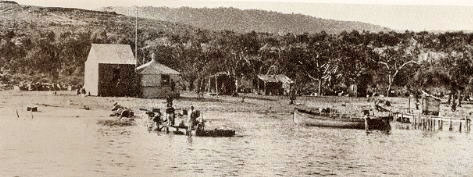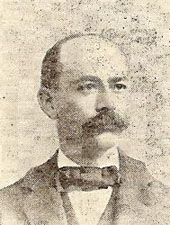

By
Robert M. Pendleton
The First Marine Battalion saw service in Cuba, being the first unit to actually land and become engaged. The action set the path for the Marine Corps into the 20th and 21st centuries.
Unit History:
Organization of the First Marine Battalion at Brooklyn Navy Yard, New York City:
The day following the sinking of the U.S.S. MAINE, Commandant of the United States Marine Corps, Colonel Charles Heywood issued orders to Lt. Colonel Robert W. Huntington, Commander of the Marine Barracks, New York Navy Yard, New York City, New York, to organize two Marine battalions for action in Cuba.
Marines from east coast posts, stations, and receiving ships assembled at New York Navy Yard but it was quickly realized that there would not be enough Marine Corps personnel to comprise a complete second battalion. The 650 Marines present were then organized as the First Marine Battalion (Reinforced) into 6 companies: A, B, C, D, E, and F (Artillery), Lt. Colonel Robert W. Huntington, Commanding.
On Friday, 22 April, the First Marine Battalion boarded the Auxiliary
Cruiser, U.S.S PANTHER. At 8:00
p.m. the ship pulled away from the dock as the Brooklyn Navy Yard band
played “The Girl I Left Behind Me.”
Voyage to Key West, Florida via Hampton Roads, Virginia
During the evening of 23 April, Panther reached Fort Monroe off Hampton Roads, Virginia and there waited three days for her escort ship the cruiser U.S.S. MONTGOMERY. On Friday, 29 April they arrived at Key West where the battalion disembarked to await the arrival of the much larger U.S. Navy transport ship RESOLUTE.
On Tuesday, 7 June, Key West Naval Station received a telegram from
the acting secretary of the Navy that stated “Send the Marine Battalion
at once to [Admiral] Sampson without waiting
for the Army send YOSEMITE as convoy.” The
battalion was forced to reboard the smaller PANTHER
as RESOLUTE had not arrived.
Voyage to Guantanamo Bay, Cuba
At 1:00 p.m. on Friday, 10 June, PANTHER arrived at Guantanamo Bay, Cuba, where the outer bay was dominated by ships of the United States Navy. Included in the mix were several private vessels carrying newspaper reporters.
At 2:00 p.m. four companies of the battalion disembarked and were quickly pulled to shore by steam launches. The other two companies remained on board to help unload supplies. Company C was the first to go ashore and deployed to the top of a hill above a fishing village which was located at Playa del Este (Fisherman’s Point). Sgt. Richard Silvey, Company C, planted the United States flag for the first time on Cuban soil at the camp on the hill soon to be named Camp McCalla by Colonel Huntington.
The first night of their arrival passed quietly and
uneventfully.

First Contacts by Spanish Troops and Cuban Irregulars
On Saturday, 11 June, the two remaining companies disembarked. Awaiting the Marines was the Spanish First Battalion of Prince’s Infantry Regiment Nr. 3 and Cuban irregulars, under the command of Lt. Colonel Jose Patino Rodriguez. When this battalion first arrived in Cuba in 1895 it was sent to Guantanamo and brigaded into the Second Brigade, Second Division, 4th Corps under the command of General Arsenio Linares y Pombo. During late afternoon the first Spanish attack took place on the outlying Marine outposts. The first Marines to be killed were Privates William Dumphy and James McColgan of D Company. The enemy made five separate attacks on Camp McCalla which were all repulsed.
At 1:00 a.m., Sunday, 12 June, Spanish forces made a more concerted attack. At that time Acting Assistant Surgeon John Blair Gibbs, U.S.N., was struck in the temple by a Spanish Mauser bullet and fell mortally wounded. At approximately the same time Sergeant Charles Hampton Smith of Company D, on picket duty, was shot through the chest and killed. Four other Marines from the same company, also on picket duty, were wounded. Later that evening Pvt. Goode Taurman, a member of Company D, during preparations for an attack against Spanish Infantry at an old fort located near the cliffs at the mouth of the bay, accidentally fell from the cliffs to the rocks below and was killed. His body was recovered the next day by a ship's boat. Acting Sgt. Major Henry Good was killed by a sniper at approximately 2:00 a.m.in the early morning of Monday, 13 June.

Acting Assistant Surgeon John Blair Gibbs
Action at Cuzco Beach
On Monday, 13 June, the Spanish firing on Camp McCalla persisted and on the 14th, after nearly three days of constant attacks and sniper fire, Colonel Huntington decided to attack the Spanish regular and Cuban loyalist forces of about six companies protecting their only fresh water supply near Cuzco Beach (the Marines were supplied with desalinated water processed aboard the ships for drinking and cooking). The beach was located approximately six miles southeast of Camp McCalla.
The Marine action at Cuzco Beach is known as the Battle of Cuzco Well. Companies C and D joined by more than fifty Cuban insurgents and supported by the gunfire of the U.S.S. DOLPHIN engaged the enemy for most of a blistering hot day. The battalion reached its objective, destroying the well. Spanish casualties were 60 killed, 150 wounded and 38 captured. The Marine casualties were 2 wounded with 23 suffering heat exhaustion; the Cuban insurgents lost 2 killed and 2 wounded. Marines, Sgt. John H. Quick and Private John Fitzgerald were awarded the Navy Medal of Honor.
The result of the battle was that the Spanish forces were entirely cut
off from their source of fresh water and were forced to retreat from the
region. Thereafter, enemy attacks on the Marine encampment at Guantanamo
Bay were dramatically reduced to incidents of sniper fire.
Departure of the First Marine Battalion for the Invasion of Manzanillo, Cuba
On Friday, 5 August, the battalion broke camp and boarded the Army transport U.S.S. RESOLUTE. On the 9th the ship, under convoy of the NEWARK and accompanied by ALVARADO, HIST, OSCEOLA, and SUWANEE, departed Guantanamo Bay. The battalion’s new assignment: to capture the town of Manzanillo located on the coast northwest of Guantanamo Bay.
On Friday, 12 August, they arrived anchoring a few miles
offshore. The ALVARADO,
under a flag of truce, was sent to demand the surrender of the town but
the Spanish commander refused. The ships began a bombardment which
ceased in the evening and resumed early the next day. At dawn white
flags could be seen flying from most of Manzanillo’s buildings. A small
boat was dispatched from the town, carrying a message which was
delivered to Captain Goodrich aboard the NEWARK . The message stated
that an armistice had been proclaimed and that the war was over.
The Voyage Home and Disbandment of the First Marine Battalion
The RESOLUTE's returned to Guantanamo Bay from Manzanillo on Monday, 15 August arriving at 1:00 p.m. The ship was coaled and on that day, according to Colonel Huntington's report to Commandant Heywood, certain officers and men of the United States artillery were taken on board. The ship departed Guantanamo Bay at 8:00 a.m. on Thursday, 18 August en route to Montauk Point, Long Island, New York , where on Tuesday, 23 August, the Army passengers were disembarked.
On Friday, 26 August RESOLUTE arrived at Portsmouth Naval Ship Yard, Seavey Island, Kittery, Maine at 7:30 p.m. anchoring off Kittery Point. The next day the battalion disembarked from the RESOLUTE and marched to Camp Heywood, Portsmouth Naval Shipyard, Seavey Island. On September 15, 1898, a parade was organized by the people of Portsmouth, New Hampshire in honor of the First Marine Battalion (who led the parade). At the end of the parade, which included other military units and the Haverhill City Band, the men enjoyed a clam bake on Pierce's Island, near Portsmouth, New Hampshire.
On Friday, 23 September 1898, at 8:30 a.m. the First Marine Battalion
(the Guantanamo Marines) arrived for the last time at New York Navy
Yard, New York City, and there it was officially disbanded with each
member returning to the Marine posts from which they had been assigned.
Casualties
Acting Assistant Surgeon John Blair Gibbs, U.S.N., M.C.
His remains were transferred to the care of his uncle, Dr. Oliver Wolcott Gibbs, at Newport, Rhode Island. He is buried beside his father at St. Mary's Episcopal Church, 324 East Main Road, Portsmouth, Rhode Island.Acting Sergeant-Major Henry Good, U.S.M.C.
Interred at the United States Naval Cemetery, New York Navy Yard, New York City, New York.Sergeant Charles Hampton Smith, U.S.M.C.
Interred at Deerpark Methodist Cemetery, Smallwood, Carroll County, Maryland.Private William Dumphy, U.S.M.C.
Interred at the United States Naval Cemetery, New York Navy Yard, New York City, New York.Private James McColgan, U.S.M.C.
Interred at St. Patrick Cemetery, Stoneham, Massachusetts.Private Goode Taurman, U.S.M.C.
Interred at Richmond, Virginia. The Cemetery of interment is currently unknown.
Nalty, Bernard C.' The United States Marines in the War With Spain. Historical Branch, G-3 Division, Headquarters, U.S. Marine Corps, Washington, D.C, 1967.
Plante, Trevor K., "New Glory to Its Already Gallant Record: The First Marine Battalion in the Spanish-American War." Prologue: The Journal of the National Archives. Vol. 30, No.1 (Spring 1998).
Report of the Secretary of the Navy, 1898, Marine Corps, Department of the Navy, Naval Historical Center, Washington Navy Yard, Washington, D.C.
Documentation regarding the shipment of the remains of the battalion's casualties to Brooklyn Navy Yard in 1899, War Department, Records of the Office of the Quartermaster General, Document from file #122512, entry 89, General Correspondence, 1890-1914, Record Group 92.
Diaz, Francisco Jose. "Prince's Infantry Regiment Nr. 3." The Spanish-American War Centennial Website, http://www.spanamwar.com/principe3.htm